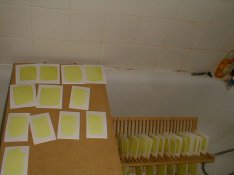What I'm a little confused about is that my sensitizer isn't turning green upon drying, it is already pale green right out of the bottle. It's not changing color as it dries.
Your sensitizer color sounds okay , it should be greenish-yellow.
Perhaps something like this:
http://en.wikipedia.org/wiki/Chartreuse_(color)
As long as it is not blue.
Now about the wash off; I'm not sure about that, could your water be alkaline? Develop the print in a 3% citric acid solution for about a minute or so and then follow with a 20 minute water bath development. If you still have a heavy blue wash then develop the entire time in a 3% citric acid solution. Follow up with a 30 min water wash. You can do about 5 prints with the citric solution.
To arrive at the correct exposure time, expose a step tablet until the first couple of steps or so look solarized. That ahould tell you the basic printing time.
I think you are on the right track.
Now just to clarify things in case others are reading this;
it is not necessary to gelatin size paper for cyanotype printing! Ware's cyanotype process is paper fussy and he recommends Buxton paper which is expensive as hell, so the paper part is tricky
Now having said that I do gelatin size Fabriano Artistico Extra white when I plan on printing gum over cyanotype so in that case if you only wanted to print cyanotype with that paper it might be worth it since it is a nice paper, but be warned FAEW doesn't like the cyanotype process, but I don't use the New Cyanotype solution for gum overs.
If all else fails try a soak in 2% oxalic acid for 5 minutes. I've never done that but it might work.
Good luck,



